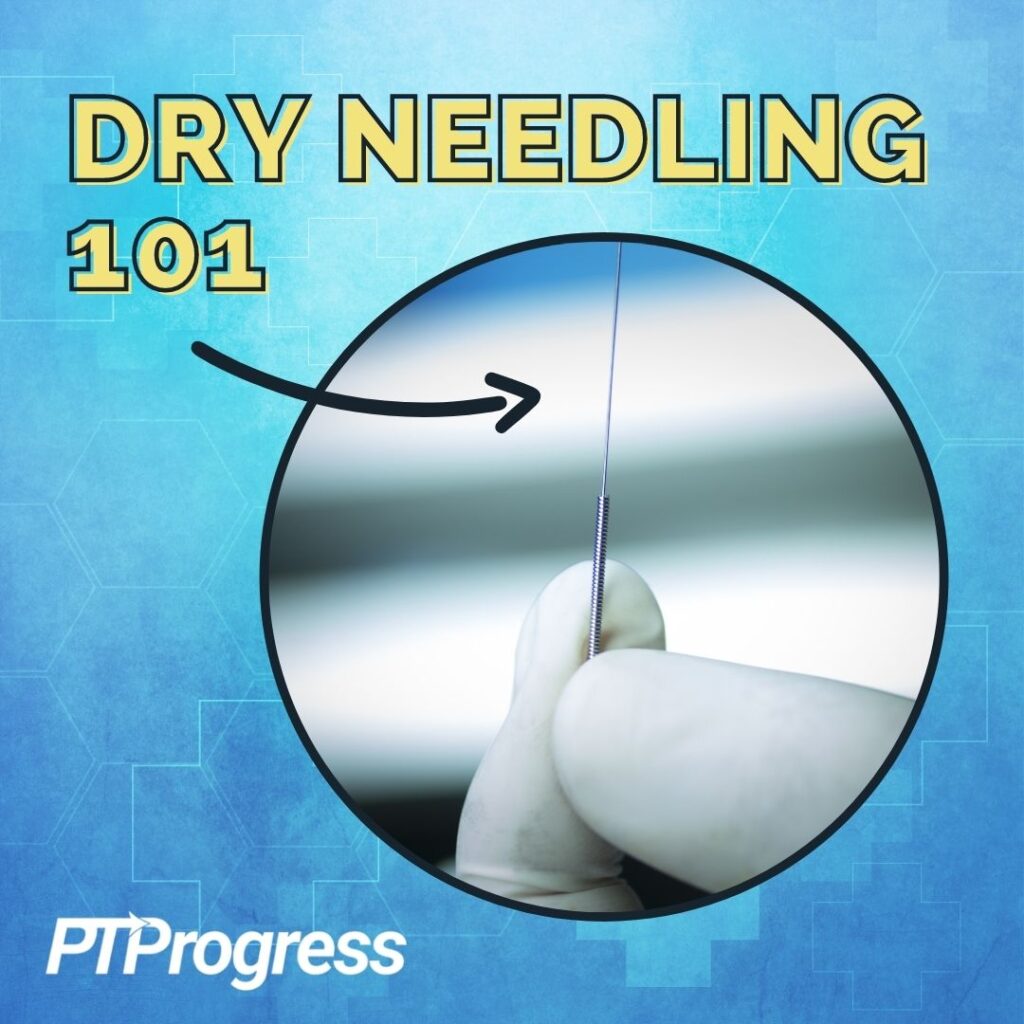
A relatively new addition to the physical therapist’s toolbox, dry needling is the practice of sticking small pins in tight muscle tissue. As opposed to a hypodermic needle, “dry” needles don’t hold any medication or fluid. Instead, they are simply inserted, in a range of depths and durations, into specific points on the body to help ease muscle spasms and chronic pain.
History and Development
Needle injections have been a part of medical practice as far back as the 1600s, but it wasn’t until the mid-20th century that physicians began using needles to relieve chronic pain through medicated injections.
In 1979, Czech physician Karel Lewit maintained that it wasn’t so much the medication but the act of needling itself that brought about an analgesic benefit—what he deemed “the needle effect.” Thus, the practice of dry needling took off.
There are two main methods of dry needling: trigger-point and intramuscular stimulation.
Trigger-point method
The more widespread method of the two, trigger-point needling follows the work of Dr. Janet Travell and fellow researchers who, in the 1940s, explored the role of myofascial tender points or “trigger points” in chronic pain.
A trigger point is a taut band of muscle tissue that is stiff yet tender to the touch. It may refer pain to other parts of the body and even restrict the patient’s range of motion. Often located in the shoulders, neck, or back, trigger points can form from trauma, prolonged poor posture, or the overuse of a muscle or joint.
The goal of the trigger-point method is to alleviate pain by stimulating the spastic muscle to relax. A tiny needle is usually imperceptible when inserted into normal muscle tissue. But when it’s inserted into the trigger point of tight muscle tissue, the muscle will theoretically contract, lengthen and relax.
IMS method
Other contributions to the practice came from acupuncture, which I’ll contrast later in this article. Dr. Chan Gunn was president of the American Society for Acupuncture in the 1980s when interest in dry needling began to proliferate. Drawing on his holistic practice in acupuncture, Gunn developed a type of medical-based needling called intramuscular stimulation or IMS.
The goal of IMS is to treat pain at its neurological source. Instead of targeting a specific trigger point, IMS focuses on a wider region of pain and generally uses a more holistic approach than other methods. IMS patients undergo a thorough examination and deliberate diagnosis before receiving treatment. Its unique approach to pain management has helped alleviate otherwise enigmatic conditions such as neuropathy.
Proposed Benefits of Dry Needling
Besides relaxing muscles, there are a few reasons why dry needling is thought to be so therapeutic.
Some theories propose that when a trigger point is punctured, it can’t stay knotted together as easily. Those pokes weaken its hold on the muscles, effectively cutting off the pain it refers elsewhere.
Another theoretical outcome of needling is the increase in flexibility it can lend. Those pinpricks are thought to help muscles mobilize—which in turn helps them lengthen, stretch, and return to normal functioning.
Although a dry needle looks tiny to us, it’s a big deal to blood cells. The small lesion it leaves behind may actually increase blood flow, initiating a valuable healing response for tight muscles.
Finally, when compared to other pain relief methods, dry needling is fairly innocuous. It’s certainly less toxic to the body than a reliance on pain medication. Plus, the approach is efficient and, fittingly, to the point. Instead of numbing the patient’s discomfort, proponents of dry needling believe it can actually treat it at its source.
Research Behind Dry Needling
Because the development of dry needling is relatively recent, research into its efficacy is minimal and narrow in scope. The vast majority of relevant research focuses on pain relief for myofascial trigger points.
One notable example is the mitigating effect of dry needling on neck and upper trapezius pain in this systematic review, which many studies cite as strong evidence for needling benefits. In one case, dry needling preceded a significant improvement in pain, pressure, and range of motion in the spastic shoulders of stroke patients. According to these and similar studies, needling appears to be a safe and viable option for treating pain in the short-term.
The support is lacking, however, for dry needling as a long-term solution to chronic pain. This may simply reflect the lack of standardization for the practice, which can further muddy research methodologies and conflate results.
Therefore, if you have mild to moderate pain, trigger-point needling may provide substantial relief in the short-term. But it may or may not be more effective than other pain relief methods in the long-term.
Uses for Dry Needling
Dry needling most often treats musculoskeletal or sports injuries, but many other conditions apply, such as the following:
- Sore, arthritic joints
- Low back pain
- Muscle Tension
- Cramps and neuralgia
- Spinal issues, such as sciatica and stenosis
- Tendinitis and overuse injuries
- Migraine and tension headaches
- Temporomandibular joint disorders, such as TMD
- Whiplash and neck pain
No matter the ailment, however, dry needling is most effective when used concurrently with other physical therapy treatments.
Dry Needling: What to Expect
If you’re interested in experiencing “the needle effect” for yourself, it may be helpful to know what to expect.
The particular details of a dry needling session will depend largely on the method of dry needling your practitioner employs. For instance, if they practice deep dry needling, they may leave the needles deep in your muscle’s connective tissue for 10–15 minutes. With superficial dry needling, your practitioner will poke your trigger points repeatedly in an in-and-out, “sparrow pecking” pattern until they get a local twitch response.
Most of the time, however, the needle is left in for up to 30 seconds at a time, at a depth of 5 to 10 millimeters.
Because the needles are so small, you may not feel them at all. However, once a trigger point has been poked, you will likely feel a cramp or “shot” of the pain you usually feel. That’s the twitch response many practitioners seek, so you may feel your muscle fibers jumping and twitching throughout the session. It shouldn’t be any more painful than what you’re used to.
Once you get up from the table and head to your car, you might not feel much better right away. The same old myofascial pain might still linger at first, but over the next few hours your pain may decrease and even disappear. In its place, you may feel muscle soreness akin to what you get after exercising. The next day, once the soreness has faded, you should feel considerable relief in pain and range of motion.
Contraindications for Needling
Needles aren’t for everyone. Although you won’t find as many contraindications for dry needling as you would for many other pain relief treatments, there are a few to be aware of.
Avoid dry needling if you have the following conditions:
- Bleeding disorders
- Diabetic Neuropathy
- Lymphedema
- Metal allergies
- Vascular disease
- Strong fear of needles
- Other medical reasons as noted by your physician
One significant risk to dry needling has to do with the implementation of a needle—something that could potentially deliver bacteria right into your body. However, a trained professional will make all the precautions necessary to ensure their equipment is sterile and safe.
Dry Needling vs Acupuncture
When the words “needles” and “therapy” show up in the same sentence, most people think of acupuncture. But, despite appearances, dry needling and acupuncture are very distinct therapies.
Both acupuncture and dry needling insert thin needles into strategic parts of the body to promote wellness. Besides that, they differ in the following ways:
Tradition
Acupuncture and dry needling come from two distinct schools of thought: one from traditional Chinese medicine and the other from Western medical practice. Acupuncture follows the tradition of human meridians, whereas dry needling relies on human anatomy and current medical research.
Purpose
Although acupuncture may result in pain relief, it has a more holistic purpose: to stimulate nerves and activate a person’s Qi, or flow. The goal of dry needling is primarily to relieve pain by stimulating muscle spasms or knots.
Application
Acupuncture is used for a conglomerate of maladies, be it tension, cramps, headaches, depression, or even nausea. Dry needling primarily treats tension and pain in specific muscle tissue.
Method
An acupuncture session is usually a full-body experience, with the needles left in place for 10 to 30 minutes. The IMS method aside, dry needling usually only focuses on the site of the pain, not the full body. Unlike acupuncture, dry needles usually stay in place for only a few seconds or minutes at a time.
Regulation
Perhaps one of the most salient differences between the two therapies is how they are regulated. Acupuncture has been around for literally millenia, and today’s practitioners follow a particular set of regulations, set by the NCCAOM, to earn certification. Dry needling, on the other hand, lacks a centralized regulating body and, as a result, a universal standard of practice.
Physical Therapy and Dry Needling
With their intimate knowledge of anatomy and pain management, Physical Therapists already have 80% of the knowledge they need to offer this practice. The needling technique itself, as well as any other specialized skills, they can learn through special continuing education courses.
But not every state lets PTs practice dry needling, regardless of training. Below is a map depicting where you can and cannot receive this treatment from a PT.
These restrictions may change in time. The FSBPT (Federation of State Boards of Physical Therapy) recently published some “competencies” they deem necessary for PTs to safely administer dry needling. In the coming years, more State Boards may start to use these competencies to establish regulations and legalize PT-administered dry needling.
Summary
It’s no fun getting poked with needles, but neither is chronic pain. If you have a fear of needles that is truly insurmountable, then there are plenty of other ways you can treat your pain.
Chronic pain from muscular tightness can be treated with a trifecta of mobility drills, stretches, and exercises. Mobility drills help mobilize the area, stretching helps lengthen the myofascial band, and exercises strengthen the muscles to help prevent future overuse and pain.
But if exercise therapy isn’t in the cards for you right now, you might consider a couple other modalities we use in the physical therapy clinic, such as myofascial massage, TENS (transcutaneous electrical nerve stimulation), or maybe even dry needling!

